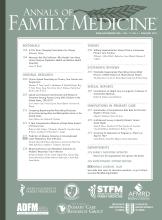Abstract
PURPOSE Health coaching is effective for chronic disease self-management in the primary care safety-net setting, but little is known about the persistence of its benefits. We conducted an observational study evaluating the maintenance of improved cardiovascular risk factors following a health coaching intervention.
METHODS We performed a naturalistic follow-up to the Health Coaching in Primary Care Study, a 12-month randomized controlled trial (RCT) comparing health coaching to usual care for patients with uncontrolled diabetes, hypertension, or hyperlipidemia. Participants were followed up 24 months from RCT baseline. The primary outcome was the proportion at goal for at least 1 measure (hemoglobin A1c, systolic blood pressure, or LDL cholesterol) that had been above goal at enrollment; secondary outcomes included each individual clinical goal. Chi-square tests and paired t-tests compared dichotomous and continuous measures.
RESULTS 290 of 441 participants (65.8%) participated at both 12 and 24 months. The proportion of patients in the coaching arm of the RCT who achieved the primary outcome dropped only slightly from 47.1% at 12 to 45.9% at 24 months (P = .80). The proportion at goal for hemoglobin A1c dropped from 53.4% to 36.2% (P = .03). All other clinical metrics had small, nonsignificant changes between 12 and 24 months.
CONCLUSIONS Results support the conclusion that most improved clinical outcomes persisted 1 year after the completion of the health coaching intervention.
- primary care
- patient-centered care
- chronic care
- patient self-care support
- health promotion
- disease prevention
- health behavior change
- special population
- underserved patients
- minority health
- practice-based research
- Received for publication June 26, 2015.
- Revision received December 2, 2015.
- Accepted for publication December 15, 2015.
- © 2016 Annals of Family Medicine, Inc.







